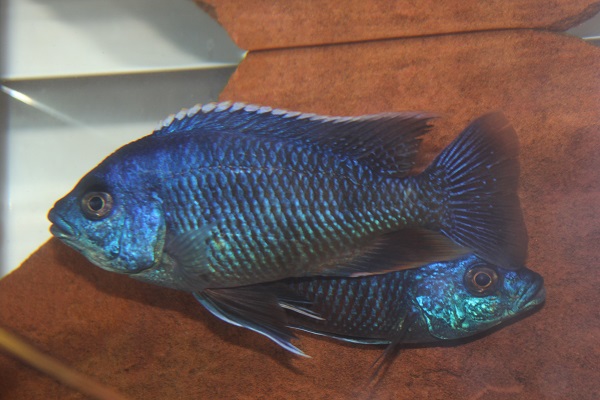The photo is of two Non-Gold Dragon Blood Peacock Males.
A couple of days ago, I released a blog on Dragon Blood Peacock cichlids (see: http://goliadfarms.com/dragon-blood-peacock-cichlid/), which I had written months ago and had failed to post. This blog is an update on the genetics of the Dragon Blood Peacock.
We found two types of offspring from our Dragon Bloods, gold bodied (Dragon Bloods) and grey bodied (which I creatively have dubbed Non-Gold Dragon Blood Peacock). In the previous blog I’d speculated that “the gold body has to be dominant over the normal grey.” You’ll have to read the previous blog to see my reasoning.
To prove I’m correct about the dragon blood genetics, I set up two test crosses. I mated greys together to see if that would produce only greys. Also, I mated a dragon blood male to OB peacock females, which have non-gold bodies. We’ve recently processed the fish from the first of these matings. The breeding vat with the Dragon Blood male and OB peacock females is due for processing soon and I’ll blog about it at that time. Interestingly, there are many gold bodied offspring visible in that vat.
Okay, back to the matings of Non-Gold Dragon Blood Peacocks together. On February 26, 2015 I selected eight males and 30 females from a grow-out vat as breeders and placed them into a 300 gallon breeding vat. Two of the males are in the photograph above. On July 20, 2105, we processed the breeding vat and yielded 259 1-2” and 140 2-3” offspring. Not a single one was gold, all had grey bodies. These results, I believe, coupled with the fact that our gold bodied breeding colonies produce some grey bodies fish, definitively proves that the grey body color is recessive to the gold body color.
There is one more test mating I could do; I could mate one of our Dragon Blood males to grey bodied females. That mating should produce one of two results. Either all the offspring will be gold bodied or about fifty percent will be. Why? If the male is homozygous (having two genes for gold) for gold body, then all of his offspring when mated to the grey bodied females will be gold bodied since he can only pass on the gene for gold. Or, if he is heterozygous (having one gene for gold and one for grey), then about half his offspring would inherit the dominant gold gene and would be gold bodied, and the other half would inherit the recessive grey gene and would be grey bodied. They can only inherit a grey gene from their mothers since they each carry two grey genes.
By the way, such a test mating, crossing a fish with the dominant color to fish with the recessive color can tell you if a fish is homozygous for the dominant gene. For example, imagine you have a great colored fish you think is carrying a gene for albinism. You could test this by mating that fish to an albino, which is recessive to normal color. If the mating produced any albinos then you know the fish is heterozygous for albino (has one gene for normal color and one for albino). If the mating produces no albinos then the fish is likely homozygous for normal color.
Knowing a little about genetics can be useful. A good example is in Betta splendens, a fish we used to raise and likely will again. There are turquoise, steel-blue, and cornflower blue Bettas. In this case, if a fish carries two genes for turquoise, it is turquoise; if it carries two genes for steel-blue, it is steel-blue; but if it carries one gene for turquoise and one for steel-blue, it is cornflower blue. Cornflower blue is a very desirable color, but if you mate two cornflower blues together you will average 25% turquoise, 25% steel-blue, and only 50% cornflower blue offspring. How to get 100% cornflower blues? Mate a turquoise to a steel-blue.
Good fishkeeping!


Justin says
Interesting article and Betta genetics thrown in to boot.
Curious if you used your current systems and feeding styles (pellets and crumble) for the Bettas or if you produced live foods for them and fry?
Great work on the YouTube videos to.
Charles Clapsaddle says
Justin,
First, I’m sorry about the tardy reply. Some messages seem to have gotten delayed.
When we raise them, we feed Bettas like we feed our other fish. Betta fry also get Paramecium we collect from mulm in the vats. Purina makes a very fine food for fry we also use.
Charles